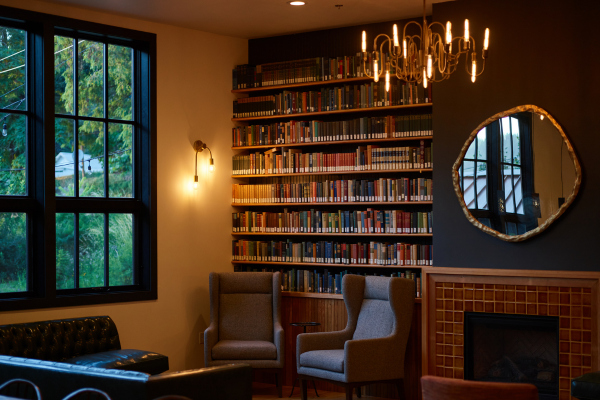“Colors express the main psychic functions of man.”
Carl Jung
Designing small spaces can be both challenging and rewarding. Although limited square footage imposes limitations, with the application of colour, one can transform a compact space into a visually appealing and functional oasis.
The power of colour psychology rests in its ability to create a shift in people’s perceptions, emotions and behaviour. Understanding how different colours affect our visual experience allows us to influence spatial perception, thereby increasing the perimeter of a room without physically modifying its size.
This artistic use of colours opens up a world of options for homeowners and interior designers looking to create aesthetically beautiful living spaces. By strategically employing colour psychology, designers can make small spaces feel more spacious, enhancing both form and function in interior design.
Our exploration of colour psychology for small spaces will take us through four critical milestones, each revealing crucial ideas and practical solutions for altering smaller rooms.
Navigating the Terrain of Furniture & Lines
The furniture choices and design components greatly influence the visual dynamics of small spaces. Choose furniture with simple lines and raised legs, allowing the light to flow beneath and create a light, airy environment.
Horizontal lines open up the walls and provide the impression of more enormous ceilings; vertical stripes drive the gaze upwards, giving the illusion of lighter ceilings. Whether they are actual or imagined, these lines create a captivating visual path through the area. In terms of interior design, furniture and lines are key elements in shaping the concept of space, particularly in small areas.
Light can penetrate underneath and give rise to a sense of openness and airiness by blending furniture with clean shapes and raised bases. In terms of interior design, furniture and lines are key elements in shaping the concept of space, particularly in small areas. Light can penetrate underneath and give rise to a sense of openness and airiness by blending furniture with clean shapes and raised bases.
To achieve a captivating and roomy ambience within a compact home, selecting furniture with elegant, streamlined designs and expanded bases and incorporating horizontal and vertical lines into the overall design can be the key. Consider utilizing Custom Furniture services to create pieces tailored to your small space’s specific needs and design preferences.
Clutter – Free Elegance through Organisation
Organization is the key to designing an adequate compact space. Adopt minimalist ideas to create a space where everything has a place and a function. Use colour psychology to guide your organizing decisions and create a serene and orderly visual landscape that allows the eye to move throughout the room. Refrain from filling every corner and cranny with decorative objects. In the alternative, each object must be thoroughly selected to ensure that it fulfils its purpose and complements the whole design scheme.
This thoughtful approach prevents visual overload and creates a sense of spaciousness. Consider alternatives to conventional storage solutions and look for unused areas. Without compromising floor space, elevated shelves, under-bed compartments, and wall-mounted organizers can discreetly store items.
Compact living benefits from furniture which can serve more than one purpose. For overnight guests, consider a convertible sofa bed or storage ottoman, which doubles as a coffee table. Without sacrificing their style, such multifunctional pieces are maximizing functionality. The colour has a significant influence on our perception of space. To create an illusion of spaciousness, select a bright and airy colour palette such as whites, creams or pale pastels. This colour reflects light and makes the room feel more extensive and more precise.
Keep windows broad and use thin curtains or blinds to maximize sunlight. Natural light adds to the spaciousness, making it feel cheerful. Transform a small space into an attractive and clutter-free retreat through the use of minimalism principles, discreet storage, multifunctional furniture, and applying colour psychology to maximize natural light.
Embracing Light & Airy Hues
The first step for designing small rooms is the colour palette, and open and light tones are the ultimate allies for organizing small spaces. The secret to creating the illusion of an expanded setting is the use of delicate whites, pastel hues and pale neutrals. These hues have a fantastic capacity to reflect light, enhancing the space and creating an open atmosphere.
Light and airy colours, especially those with a hint of coolness, offer an astonishing ability to reflect light, which allows the room to be more spacious and bright. In a room with very limited ambient light, this visual expansion has particular advantages.
A harmonious palette of colours supports the feeling of order and peace. One can create a seamless visual flow that quickly eliminates harsh contrasts and allows the eye to move through the entire room by applying a consistent colour scheme of light and airy colours. The calming effects of warm, delicate colours create a sense of calm and relaxation.
These gentle tones create an environment of peace and comfort in your compact apartment, making it feel spacious and relaxed. Finally, it’s an innovative way of designing small spaces to embrace light and airy colours. These delicate tones create an illusion of space, promote visual harmony, and foster a calm atmosphere, making your small apartment feel bigger, brighter, and more inviting.
Mirrors : Reflecting Elegance & Space
To maximize the perception of openness, designers can cleverly incorporate reflective surfaces like mirrors, cleverly using them as reflecting elements to amplify their dimensions. A well-placed mirror can not only add visual depth but also serve as a stunning focal point, further enhancing the room’s aesthetic appeal. The combination of light colours and reflective surfaces creates a luminous and breathable ambience, making small spaces feel large, more inviting and utterly captivating.
Mirrors beautifully blur the lines of a space, creating an illusion of larger dimensions. For Instance, in small bedroom interior design, strategically placed mirrors can be a game-changer. They not only visually expand the space but also enhance its welcoming ambience by reflecting light and other elements. By positioning mirrors on either side of windows or directly across from light sources, you can effectively capture and disperse natural or artificial illumination. This heightened luminosity creates a feeling of openness and airiness, making your small bedroom feel more spacious and inviting..
To enhance the architectural details, such as high ceilings or elaborate mouldings, mirrors can be used to complement a feeling of grandeur and beauty. In conclusion, mirrors aren’t just reflective substrates; they are transforming tools that enhance the image of space, amplify light and make compact living more attractive.
Strategic Accentuation with Bold Colours
Even if the psychology of colour in compact spaces is dominated by subtlety, a well-placed burst of vibrant colour may do wonders as a point of interest. Accessories, artwork, or small furniture pieces can add personality and character to the room without overpowering it by incorporating bold or brilliant colours. These thoughtfully picked accents add vitality and excitement while still preserving the balance required.
A bold-coloured accent piece, such as a colourful throw pillow, a striking piece of art, or an eye-catching vase, can instantly draw attention and become a focal point. For instance, the conversation area can be defined by a brightly coloured rug, while a bold accent wall can distinguish the workspace.
Lastly, a small space can be transformed from ordinary into exceptional by subtle pops of bold colours. These carefully selected accent pieces make a small house feel larger than life, adding personality, vitality, and visual intrigue.
Purposeful Lighting
A key component of striking interior design is effective lighting design. An arrangement of lights eliminates shadows and highlights the aesthetic of the space, which the combination of natural and artificial light can achieve. Choosing lighting fixtures that blend flawlessly with the colour scheme selected by improving the aesthetic appeal while supporting the central design concept.
To create a proper balance of illumination, combine ambient, task and accent lighting. Ambient lighting is an overall light source; task lights are targeted at specific areas, such as the office and accent lighting illuminates architectural or decorative elements. To eliminate shadows, enhance architectural features and highlight focal points, light fittings are positioned in a strategic manner.
For a sleek and modern look, consider using wall sconces to wash the walls with light, uplights to highlight high ceilings and recessed lighting. Adjusting the room’s mood and atmosphere according to needs by installing dimmer switches that control the intensity of artificial light.

Hence, small areas are transformed through colour psychology. Light colours expand, monochrome designs harmonize, and accents enliven. Mirrors, furniture, and lines all magnify and enhance illusions. The ambience is created by balancing warm and cool elements, and light adds depth. Compact interiors transcend in this symphony, demonstrating the incalculable influence of thoughtful layout.
In interior design, we’ve witnessed remarkable transformations in spaces, achieved through the ingenious use of colour psychology, deliberate layout, and strategic planning elements. Even in compact interiors, these well-thought-out design principles have triumphed over physical constraints, orchestrating a harmonious blend of elements that turn small spaces into havens of beauty, comfort, and visual delight. If you want to enhance these transformations further, consider a colour specification service to refine your design.
Author: Yogita Sawarthia & Sagar Kuchhadia (Interior Designer)





